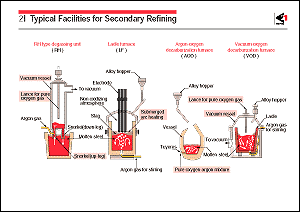In the production of high-grade
steel, refining under vacuum was initially introduced to remove
such gas components as hydrogen before casting the molten steel
tapped from the converter. This is called vacuum degassing because
the gas components in the molten steel are removed by reducing
the balanced partial pressures during and after pouring the molten
steel into a reduced-pressure vessel. The functions of temperature
control, final refining, and composition control were subsequently
added to the secondary refining equipment because the function
of the converter is increasingly concentrated on decarburization,
and further reductions in impurity elements and nonmetallic inclusions
should therefore be performed by other means. The allowable ranges
of target temperature and composition have also become tighter
requiring fine tuning. Thus, secondary refining has recently
become the standard process for producing high-grade steels.
The most important functions of secondary refining are final
desulfurization, degassing of oxygen, nitrogen, hydrogen, etc.,
removal of inclusions, and final decarburization for ultra-low
carbon steel.
Desulfurization is conducted by adding CaO, Na2CO3,
CaF2, etc. in a similar manner to
that used in the hot metal pretreatment process. Denitrification
and dehydrogenation are achieved by treating the molten steel
under reduced pressure in a vacuum vessel. Deoxidation is conducted
by adding silicon and aluminum to the molten steel to form nonmetallic
inclusions of silica (SiO2) and alumina
(Al2O3),
which are coagulated by stirring the molten steel for enhanced
flotation. These are then absorbed into the top slag and removed.
Additional decarburization, if required, is carried out by blowing
pure oxygen gas onto or into the molten steel in the vacuum vessel
to remove the carbon as carbon monoxide.
Secondary refining equipment typically used in the mass production
of high-purity steel at integrated steel mills includes the RH
(Ruhrstahl-Hausen) vacuum degasser and LF (ladle furnace). The
RH equipment injects argon gas into one (suction tube) of the
two tubes (snorkels) immersed in the molten steel in the ladle,
and the molten steel in the ladle is drawn through the suction
tube into the vacuum vessel by the operation of air-lift pumping.
After being exposed to the vacuum in the vessel, the molten steel
flows back into the ladle through the down snorkel. Since the
recirculation rate is relatively high, the RH process is suitable
for rapid degassing of a large amount of molten steel. The refining
functions of the RH process have also been expanded. For example,
decarburization and heating-up are conducted by injecting pure
oxygen gas, while the desulfurization and deoxidation rates are
increased by adding fluxes, both onto or into the melt in the
vacuum vessel. On the other hand, the LF equipment offers strong
heating functions, permits the addition of a large amount of
alloys, and enables precise temperature control. It also provides
outstanding desulfurization by high-temperature treatment with
reducing fluxes and the removal of deoxidation products. The
LF process is therefore often used for the secondary refining
of alloy steel.
Secondary refining equipment used mainly in the final refining
step for stainless steel includes the AOD furnace and the VOD
furnace. Stainless steel contains a large amount of chromium
as a basic component. Since chromium is a strong oxide-forming
element, during normal refining it is difficult to decarburize
stainless steel to a sufficiently low carbon level while preventing
loss of chromium through oxidation to the slag phase. Thus, low
carbon levels are achieved by decreasing the partial pressure
of carbon monoxide in the refining atmosphere to ensure preferential
decarburization in the presence of chromium. In practice, this
is done in the AOD furnace by dilution with argon and in the
VOD furnace by reducing the pressure. |
|
 |
 |
 |
|
|